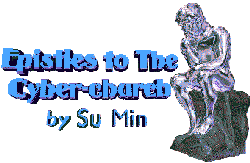
To: All
My dear children,
There is an innate sense of celebration as the farmer sees that the long bleak winter is over: as spring begins and the first shoots sprout forth and the first flowers bloom. The custom of celebrating renewal at Springtime is not new, nor is it confined to Christianity. The celebration of spring is a common feature of most agricultural societies. Indeed the word "Easter" is not found in the bible, and belongs to the Germanic languages to denote the festival of the vernal equinox. Even the Passover, which the Hebrews instituted as a commemoration of the Passover of the angel of death in Egypt, striking at the heart of Pharaoh and marking their liberation from bondage (Exodus 12), was probably a modification of an ancient spring festival. To the Christian, Easter marks the celebration of the resurrection of Jesus.
The gospels tell us there were women who went to the tomb on the first day of the week. Women mentioned in abundance, no men, at least not at first. Such was the love and devotion and adoration for their leader, that inspite of the taint of being associated with Jesus who was executed by crucifixion, the women were prepared to come to anoint his body. And even today, we see the preponderance of women who are more spiritually aware than most men, women are prepared to come to worship the Lord. The guys seem too caught up with material things. Hmm, guys, wake up.
How many women and angels were there at the tomb at dawn on the first Easter Sunday?
Mary Magdalene at first weeps, thinking that the body of Jesus has been stolen: then as Jesus calls her by name, she recognises him and calls to him "Rabbonai" (John 20:19). When the women meet Jesus, the Risen Saviour they clasp his feet and worship him (Matt 28:9).
How great is the joy of Mary Magdalene and the other women and Peter and John as they discover He has risen, just as he said (Matt 27:28): they were filled with joy (Matt 28:8). They expected to find a dead body, instead they experience the Risen Christ. This is much more a cause for rejoicing than mere spring. For in rejoicing in the resurrection of Jesus, we rejoice at our own salvation and eternal life. What more reason do we need to rejoice. What more reason do we need to shout Hallelujah! He is alive!
The action words spoke by the angel as recorded in Matt 28:6:7 make a powerful message to us as we seek an encounter with the Risen Christ. Come See Go Tell. Pronounced rhymically the words encourage us to march out to the world to spread the good news.
Let us close in prayer
From: Su Min
Subject: Easter
The Glory of the Risen Christ at Easter compels me to share with you before we go back to our systematic review of the Gospel of St Matthew.
To harmonise these accounts we can surmise that Mary Magdalene, the other Mary (mother of James) Salome, Joanna and perhaps some other women went to the tomb, followed shortly by some men, at least Peter and John. Each gospel writer chose to focus on different subsets of people. Likewise of the angels: two angels were present, one present all the time inside the tomb, the other one rolling the stone away, first sitting outside the tomb on the stone, then inside at the head of the empty niche.
The joy of meeting the Resurrected Christ should not be only celebrated once a year, but every day of our life while we are here in earth, and every day of our perfect eternal life when we are ranged round the mighty throne, together with thousands upon thousands and tens thousand times ten thousand angels singing
Worthy is the lamb that was slain to receive power and strength and wisdom, and honour and glory and praise. and
Hallelujah.
To him who sits upon the throne and to the Lamb be praise and honour and glory and power for ever and ever.
(Rev 5:12,13)
Father in heaven, thank you for our lesson today.
Thank you for letting us see beyond Easter eggs and bunny rabbits the true joy of encountering our Risen Lord.
Thank you for sending Jesus to die on the cross, a perfect sacrifice to atone for all our sins.
Help us walk in your ways that we may be worthy of this sacrifice.
Help us to know your word, that we may be worthy of His Name.
This we ask in Jesus Name. Amen.
For any comments or enquiries please write to Dr. Lim Su Min
| Back to Antioch's Well | Back to Antioch's Home Page |
![]()